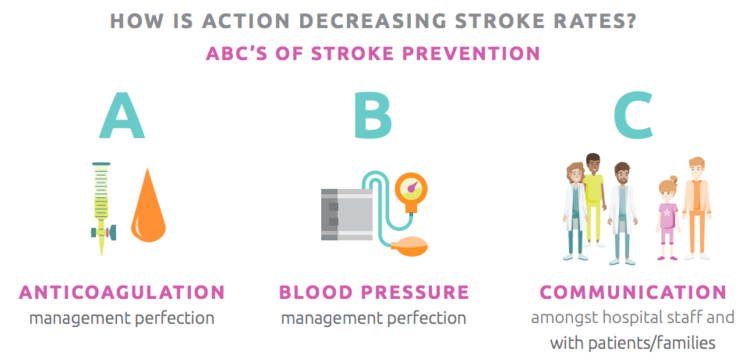
IMPROVING STROKE OUTCOMES IN CHILDREN SUPPORTED WITH A VENTRICULAR ASSIST DEVICE IN A QUALITY IMPROVEMENT NETWORK
ACTION has been working to reduce the frequency of stroke associated with pediatric VAD care ever since we were established in 2017. Previous studies showed stroke rates in children on VADs ranged from 10% to 29% depending on device. We introduced the ABC’s of Stroke Prevention to standardize care and—ultimately—improve outcomes. This report describes how ACTION’s ABCs of Stroke Prevention were developed and implemented, as well as contemporary stroke outcomes in this rapidly evolving field: “ABCs of Stroke Prevention: Improving Stroke Outcomes in Children Supported With a Ventricular Assist Device in a Quality Improvement Network” (December 2020).

The report highlights practice variability across pediatric heart centers in 3 domains: anticoagulation, blood pressure, and communication: “The ABCs of Stroke Prevention was a series of interventions focused on (1) standardizing anticoagulation in patients supported on a Berlin EXCOR, (2) developing and standardizing blood pressure measurement/goals, and (3) developing a method for communicating goals to families and bedside providers. The protocols, patient education, and methods for intra-network communication were designed to be scalable and adaptable while holding the basic tenets of the original interventions.”
The network created a one-page Stroke Prevention Checklist for reviewing anticoagulation and blood pressure goals to facilitate daily discussion and documentation of these goals. Additionally, ACTION leaders made a template for new centers to adopt the ABCs of Stroke Prevention and subsequent projects. These ABCs have dramatically decreased the rate of stroke to <12% in Berlin Heart and <5% in implantable VADs. And ACTION centers are initiating new projects to further reduce this risk. Looking forward: A rigorous comparison to historical data is underway to help refine stroke prevention protocols and data collection. Furthermore, the network has begun work on further optimizing anticoagulation practices.
Multicenter collaboration is key to rapidly standardizing care management protocols, best practices, and guidelines. Congratulations to the ACTION investigators for making this possible and co-authors for getting this report published in a high-impact journal, Circulation: Cardiovascular Quality and Outcomes CARE: Chet Villa of Cincinnati Children’s Hospital Medical Center and Christina VanderPluym of Boston Children’s Hospital.
ACTION investigators include Angela Lorts, David Morales, Farhan Zafar, Paige Krack, Lauren Smyth, Katrina Fields, David Rosenthal, Jenna Murray, Beth Hawkins, David Peng, David Sutcliffe, Jodie Lantz, Scott Auerbach, Meghan Williams, Matthew O’Connor, Rachel White, Robert Niebler, F. Bennet Pearce, Meloneysa Hubbard, Matthew Zinn, Allison Reichhold, Anna Joong, David Bearl, Deipanjan Nandi, Robert Gajarski, Michelle Ploutz, Lindsay May, Mary Mehegan, Kathleen Simpson, Jennifer Conway, Nicole Dubyk, Hari Tunuguntla, Barbara Elias, Aamir Jeewa, Jeffrey Gossett, and Mary Gowen.
CITATION
Villa CR, VanderPluym CJ; ACTION Investigators*. ABCs of Stroke Prevention: Improving Stroke Outcomes in Children Supported With a Ventricular Assist Device in a Quality Improvement Network. Circ Cardiovasc Qual Outcomes. 2020 Dec;13(12):e006663. doi: 10.1161/CIRCOUTCOMES.120.006663. Epub 2020 Dec 15. PMID: 33320692.
